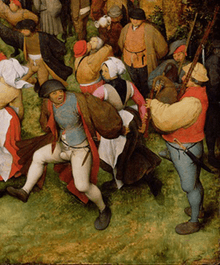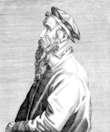The Wedding Dance
The Wedding Dance (sometimes known as The Dance Village) is a 1566 oil-on-panel painting by Pieter Bruegel the Elder. Owned by the museum of the Detroit Institute of Arts in Detroit, Michigan, the work was discovered by its director in England in 1930, and brought to Detroit. It is believed to be one of a set of three Bruegel works from around the same time,The Wedding Dance, The Peasant Wedding (1567) and The Peasant Dance (1569).
| The Wedding Dance | |
|---|---|
.jpg) | |
| Artist | Pieter Bruegel the Elder |
| Year | 1566[1] |
| Medium | oil-on-panel[2] |
| Dimensions | 119.4 cm × 157.5 cm (47 in × 62 in) |
| Location | Detroit Institute of Arts, Detroit, Michigan |
The painting depicts 125 wedding guests. As was customary in the Renaissance period, the brides wore black and men wore codpieces. Voyeurism is depicted throughout the entire art work; dancing was disapproved of by the authorities and the church, and the painting can be seen as both a critique and comic depiction of a stereotypical oversexed, overindulgent, peasant class of the times.
Background
Pieter Bruegel the Elder completed The Wedding Dance in 1566. It was believed to have been lost for many years, until discovered at a sale in London in 1930 by William R. Valentiner, the director of the Museum Detroit Institute of Arts at the time.[3][4][5] Valentiner paid $35,075 for The Wedding Dance through a city appropriation.[6] It is still owned by the museum.[6]
The Peasant Wedding (1567) and The Peasant Dance (1569) are also by Bruegel which share the same wedding theme and elements and were painted in the same period in Bruegel's later years. They are considered to be a trilogy of works by Bruegel.[7][8] In all three of the paintings, there are pipers playing the pijpzak (bagpipes), they also exude pride and vanity, for example in The Peasant Dance the man seated next to the pijpzak player is wearing a peacock feather in his hat.[9][10]
Robert L. Bonn, an author, described these trilogy of works as "superb examples" of anthropological paintings, and states that "in three genre paintings Bruegel stands in marked contrast both to painters of his day and many others who followed."[7] Thomas Craven summarises The Wedding Dance as "One of several celebrations of the joys of gluttony painted by Brueghel with bursting vitality".[11] Walter S. Gibson also views the paintings as a "sermon condemning gluttony" and "an allegory of the Church abandoned by Christ."[12]
Description and themes

The popular[13] painting shows a group of 125 wedding guests wearing clothing from the times, presented in the canvas in an apparently chaotic way in an outdoor party surrounded by trees.[14][15][16][17] The brides wore black as it was the Renaissance period and the men wore codpieces, which were an important part of their clothing at the time.[18][19] Voyeurism (spying on people engaged in intimate behaviours) is shown throughout the entire work amongst almost all of the people.[20]
In the foreground there is a dancer wearing the colours of that time period and there are many peasants in that area. In the middle there is the bride dancing with an older man, her father.[21] On the right of the work, there is a musician playing on a pijpzak, who is watching the dance from the side.[22] Judging by the writing utensils hanging on his belt, he is a writer or possibly a middle-class painter. Behind him is a hanging tablecloth decorated with a crown and beneath it is the bride's table. Before her table, money collectors can be seen digging trenches while the wedding guests sit down and eat.[23]
The movements of the people show that their behaviour is inappropriate or a caricature of rustic buffoonery, but its representation of fertility and reproduction is presented in a joyful manner.[18][23] Indeed, the painting reflects a degree of ambiguity in that it can both be seen as an attack on the stereotypical oversexed behaviour of the lower orders as well as evoking a comical picture.[24] In the sixteenth century, when this was painted, dance was subject to a strict code and regarded by the authorities and church as a social evil.[24] People could not swing their arms or legs or laugh too loud, as that would be considered a type of rudeness to many people.[24] The painting therefore "expresses the peasants' liberation from the stricter limits of upper classes" by failing to adhere to the expected social standards of the times.[24][25][26]
The author of The Theme of Music in Northern Renaissance Banquet Scenes, Robert Quist, has said that the painting was part of a series of Seven Deadly Sins and Virtues and that the paintings "attest to [Bruegel's] moral devotions". He says "While dancing may appear innocuous or natural for peasants, it poses a palpable threat to the human soul. Its [dancing] usefulness in characterizing the peasantry as wild and unruly undoubtedly derives from the moral opprobrium in which dancing was held by religious and civil authoriries alike.[24]
References
- "Pieter Bruegel the Elder". History of Art:Renaissance. Retrieved June 4, 2012.
- "Pieter Bruegel the Elder". The Athenaeum. Retrieved June 4, 2012.
- Detroit Institute of Arts; Henshaw, Julia Plummer (1985). 100 masterworks from the Detroit Institute of Arts. Hudson Hills Press, in association with the Founders Society, Detroit Institute of Arts. Retrieved 4 June 2012.
- Morse, John D. (1979). Old Master Paintings in North America: Over 3000 Masterpieces by 50 Great Artists. Abbeville Press. p. 31. ISBN 978-0-89659-050-2. Retrieved 14 June 2012.
- Bruegel, Pieter (1970). Pieter Bruegel the Elder. Thames & Hudson. p. 1. Retrieved 4 June 2012.
- Sterne, Margaret Heiden (June 1980). The Passionate Eye: The Life of William R. Valentiner. Wayne State University Press. ISBN 978-0-8143-1631-3. Retrieved 14 June 2012.
- Bonn, Robert L. (2006). Painting Life: The Art of Pieter Bruegel, The Elder. Bonn, Robert. p. 41. ISBN 978-1-884092-12-1. Retrieved 9 June 2012.
- Serebrennikov, Nina Eugenia; Sullivan, Margaret A (22 September 1996). "Bruegel's Peasants: Art and Audience in the Northern Renaissance". Cambridge, New York and Melbourne: Cambridge University Press, 1994: Renaissance Quarterly. Archived from the original on 14 March 2016. Retrieved 22 June 2012.CS1 maint: location (link)(subscription required)
- "Pieter Bruegel the Elder Grove Bio" (PDF). Grove Art Online — Montgomery College. Archived from the original (PDF) on 6 April 2012. Retrieved 8 June 2012.
- "Grove Bruegel". Oxford Art Online (subscription required). 2005. Retrieved 8 June 2012.
- Craven, Thomas (26 May 1977). A Treasury of Art Masterpieces. Simon and Schuster. p. 101. ISBN 978-0-671-22776-0. Retrieved 9 June 2012.
- Gibson, Walter S. (2003). The Art of Laughter in the Age of Bosch and Bruegel. Gerson Lectures Foundation. p. 33. Retrieved 9 June 2012.
- Roberts-Jones, Philippe; Roberts-Jones, Françoise (1 November 2002). Pieter Bruegel. Harry N. Abrams. p. 220. ISBN 978-0-8109-3531-0. Retrieved 9 June 2012.
- Richardson, Todd M. (1 October 2011). Pieter Bruegel the Elder: Art Discourse in the Sixteenth-Century Netherlands. Ashgate Publishing, Ltd. p. ix. ISBN 978-0-7546-6816-9. Retrieved 9 June 2012.
- "Pieter Bruegel, The Wedding Dance in the Open Air". MyStudios. Retrieved 22 June 2012.
- "Pieter Bruegel the Elder: The Wedding Dance". Detroit Institute of Arts. Archived from the original on June 6, 2012. Retrieved June 4, 2012.
- Bruegel, Pieter; Marijnissen, Roger H.; Seidel, Max (1984). Bruegel. Harrison House. p. 49. ISBN 978-0-517-44772-7. Retrieved 9 June 2012.
- Hagen, Rose-Marie; Hagen, Rainer (2005). Bruegel Rainer Hagen — All Works. Kielce: Taschen. ISBN 83-60160-19-8. Retrieved June 4, 2012.
- Chafin, Jane (5 May 2011). "Short Takes: Herzog's Cave, Picasso's Guernica, Brueghel's Wedding Dance". Pasadena, CA: Huffington Post Arts. Retrieved 22 June 2012.
- Mazzei, Rebecca (2 August 2006). "Arts: Anatomy of an artwork — The Wedding Dance". Metro Times. Retrieved 4 June 2012.
- Rynck, Patrick de (2005). How to read painting. 1. Kraków: Universitas. ISBN 83-242-0565-9.
- Rynck, Patrick de (7 December 2004). How to read a painting: lessons from the old masters. 2. H.N. Abrams. ISBN 978-0-8109-5576-9. Retrieved 4 June 2012.
- HPS Warsaw (2007). Kunsthistorisches Museum, Vienna. Great Museums. ISBN 978-83-60688-26-7.
- Quist, Robert (2004). The Theme of Music in Northern Renaissance Banquet Scenes. ProQuest. p. 166. ISBN 978-0-549-54063-2. Retrieved 9 June 2012.
- "Dancing, 16th Century". Kitchen Musician. 12 May 2012. Retrieved 6 June 2012.
- "The High Renaissance & Mannerism". All-Art. Retrieved 22 June 2012.
Further reading
- Orenstein, Nadine M., ed. (2001). Pieter Bruegel the Elder: Drawings and Prints. The Metropolitan Museum of Art. ISBN 9780870999901.CS1 maint: extra text: authors list (link) (fig. 104)
External links
| Wikimedia Commons has media related to The Wedding Dance. |
